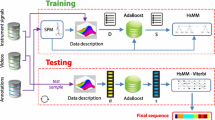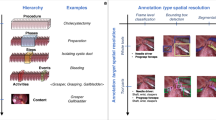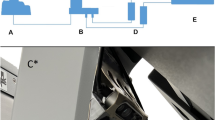Abstract
Purpose
Laparoscopic cholecystectomy is a very common minimally invasive surgical procedure that may be improved by autonomous or cooperative assistance support systems. Model-based surgery with a precise definition of distinct procedural tasks (PT) of the operation was implemented and tested to depict and analyze the process of this procedure.
Methods
Reliability of real-time workflow recognition in laparoscopic cholecystectomy (\(n=10\) cases) was evaluated by continuous sensor-based data acquisition. Ten PTs were defined including begin/end preparation calots’ triangle, clipping/cutting cystic artery and duct, begin/end gallbladder dissection, begin/end hemostasis, gallbladder removal, and end of operation. Data acquisition was achieved with continuous instrument detection, room/table light status, intra-abdominal pressure, table tilt, irrigation/aspiration volume and coagulation/cutting current application. Two independent observers recorded start and endpoint of each step by analysis of the sensor data. The data were cross-checked with laparoscopic video recordings serving as gold standard for PT identification.
Results
Bland–Altman analysis revealed for 95 % of cases a difference of annotation results within the limits of agreement ranging from \(-\)309 s (PT 7) to +368 s (PT 5). Laparoscopic video and sensor data matched to a greater or lesser extent within the different procedural tasks. In the majority of cases, the observer results exceeded those obtained from the laparoscopic video. Empirical knowledge was required to detect phase transit.
Conclusions
A set of sensors used to monitor laparoscopic cholecystectomy procedures was sufficient to enable expert observers to reliably identify each PT. In the future, computer systems may automate the task identification process provided a more robust data inflow is available.



Similar content being viewed by others
References
Kranzfelder M, Staub C, Fiolka A, Schneider A, Gillen S, Wilhelm D, Friess H, Knoll A, Feussner H (2013) Toward increased autonomy in the surgical OR: needs, requests, and expectations. Surg Endosc 27(5):1681–1688. doi:10.1007/s00464-012-2656-y
Padoy N, Blum T, Ahmadi SA, Feussner H, Berger MO, Navab N (2012) Statistical modeling and recognition of surgical workflow. Med Image Anal 16(3):632–641. doi:10.1016/j.media.2010.10.001
Feussner H (2003) The operating room of the future: a view from Europe. Semin Laparosc Surg 10(3):149–156
Cleary K, Kinsella A (2005) OR 2020: the operating room of the future. J Laparoendosc Adv Surg Tech Part A 15(5):495, 497–573. doi:10.1089/lap.2005.15.495
Kranzfelder M, Schneider A, Gillen S, Feussner H (2011) New technologies for information retrieval to achieve situational awareness and higher patient safety in the surgical operating room: the MRI institutional approach and review of the literature. Surg Endosc 25(3):696–705. doi:10.1007/s00464-010-1239-z
Bouarfa L, Dankelman J (2012) Workflow mining and outlier detection from clinical activity logs. J Biomed Inform 45(6):1185–1190. doi:10.1016/j.jbi.2012.08.003
Kranzfelder M, Schneider A, Fiolka A, Schwan E, Gillen S, Wilhelm D, Schirren R, Reiser S, Jensen B, Feussner H (2013) Real-time instrument detection in minimally invasive surgery using radiofrequency identification technology. J Surg Res. doi:10.1016/j.jss.2013.06.022
Schneider A (2006) Intraoperative Workflow Analyse bei minimal invasiven Eingriffen: intelligent workflow analysis and prediction system (IWAP). Technische Universität München
Kranzfelder M, Zywitza D, Jell T, Schneider A, Gillen S, Friess H, Feussner H (2012) Real-time monitoring for detection of retained surgical sponges and team motion in the surgical operation room using radio-frequency-identification (RFID) technology: a preclinical evaluation. J Surg Res 175(2):191–198. doi:10.1016/j.jss.2011.03.029
Tang B, Hanna GB, Joice P, Cuschieri A (2004) Identification and categorization of technical errors by Observational Clinical Human Reliability Assessment (OCHRA) during laparoscopic cholecystectomy. Arch Surg 139(11):1215–1220. doi:10.1001/archsurg.139.11.1215
Cuschieri A (1999) Laparoscopic cholecystectomy. J R Coll Surg Edinb 44(3):187–192
Neumuth T, Jannin P, Schlomberg J, Meixensberger J, Wiedemann P, Burgert O (2011) Analysis of surgical intervention populations using generic surgical process models. Int J Comput Assist Radiol Surg 6(1):59–71. doi:10.1007/s11548-010-0475-y
Miyawaki F, Tsunoi T, Namiki H, Yaginuma T, Yoshimitsu K, Hashimoto D, Fukui Y Development of automatic acquisition system of surgical-instrument information in endoscopic and laparoscopic surgey. In: 4th IEEE conference on industrial electronics and applications, 2009, pp 3058–3063
Bouarfa L, Akman O, Schneider A, Jonker PP, Dankelman J (2012) In-vivo real-time tracking of surgical instruments in endoscopicvideo. Minim Invasive Ther Allied Technol 21(3):129–134. doi:10.3109/13645706.2011.580764
Acknowledgments
Dres. Kranzfelder, Schneider, Fiolka, Reiser, Wilhelm and Feussner as well as Mr. Koller and Mr. Vogel have no conflicts of interest or financial ties to disclose. This paper was supported in part by DFG project “Single-Port-Technologie für gastroenterologische und viszeralchirurgische endoskopische Interventionen“ (FOR 1321).
Author information
Authors and Affiliations
Corresponding author
Rights and permissions
About this article
Cite this article
Kranzfelder, M., Schneider, A., Fiolka, A. et al. Reliability of sensor-based real-time workflow recognition in laparoscopic cholecystectomy. Int J CARS 9, 941–948 (2014). https://doi.org/10.1007/s11548-014-0986-z
Received:
Accepted:
Published:
Issue Date:
DOI: https://doi.org/10.1007/s11548-014-0986-z




